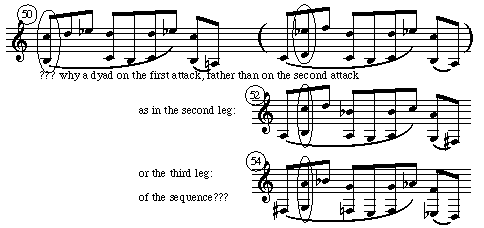
|
|
John Roeder, "Pulse Streams and Problems of Grouping and Metrical Dissonance in Bartók's 'With Drums and Pipes,'" Music Theory Online 7.1 (2001) | << Sect. 7a | Section 7b | Sect. 8a >> |
| Article Contents | ||||
[7.4] The next example (VII.1b) sounds only the percussion doublings of the streams, without the piano part. It makes the changes in stream combinations from one block to the next especially vivid.
(Example VII.1b) [click here
for suggestions
if the movie does not appear or play correctly]
Click here to rehear Example VII.1a
[7.5] As the new material of the next block is established, the new pulse stream 13 is sustained by the interaction of accents in the two hands. At first it corresponds to the notated downbeats, but it persists even when the meter signature starts to vary in m. 51. The right-hand side of Figure 4 identifies three sources of accent in this passage: the accent of dyad change in the right hand, as suggested by the reduction in the staff above the score; the durational accent in the left-hand melody, and the weaker accents of registral density when three pitches are attacked simultaneously. The vertical dotted lines cutting across stream 13 show how it is sustained by the regular succession of accents of these three types in alternation. Stream 4 is similarly maintained across the change of material, first through the durationally accented D octaves in m. 48, then through the regularly spaced but different types of accent in both voices, as shown by the vertical dotted lines in the figure.
[7.6] A small compositional inconsistency in m. 50 seems puzzling at first glance. Comparing the first leg of the sequence in the right hand, which begins at this point, with the later legs, as in the example below, we observe that Bartók treats the incipits differently. In the first leg, the first attack has a vertical dyad and the second attack has a single note, whereas in all subsequent legs the dyad appears on the second attack.
(Example VII.2)

[7.7] Figure 4 suggests a reason for this difference. The initial dyad in the first leg, m. 50, appears exactly in time to sustain whole-note stream 12, which would otherwise vanish. The lack of accent on the second attack helps put a stop to the dotted-quarter stream 10. That stream has persisted for some time now, and it could easily be heard to continue into the next block if an accent were provided here. Rather, the accent of the first attack ensures continuity from one block to the next, by sustaining stream 12 one last time. Moreover the lack of accent on the second attack creates a contrast of stream-ensemble content between the blocks, by halting a previously prominent stream.
| << Sect. 7a | Section 7b | Sect. 8a >> |
| Article Contents | ||
This page is covered by the copyright notice on the article Table of Contents page.